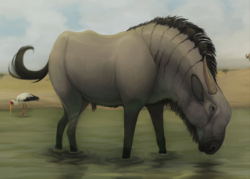Biology:Rusingoryx
| Rusingoryx | |
|---|---|

| |
| Rusingoryx drinking | |
| Scientific classification | |
| Domain: | Eukaryota |
| Kingdom: | Animalia |
| Phylum: | Chordata |
| Class: | Mammalia |
| Order: | Artiodactyla |
| Family: | Bovidae |
| Subfamily: | Alcelaphinae |
| Genus: | †Rusingoryx Pickford & Thomas, 1984 |
| Species: | †R. atopocranion
|
| Binomial name | |
| †Rusingoryx atopocranion Pickford & Thomas, 1984
| |
| Synonyms | |
| |
Rusingoryx is a genus of extinct alcelaphine bovid artiodactyl closely related to the wildebeest. It contains only one species, R. atopocranion, that lived on the plains of Kenya during the Pleistocene.[1] It was originally named as a species of Megalotragus.
Rusingoryx is known for its strange pointed nose with a large nasal dome. This structure represents an instance of convergent evolution with the crests of hadrosaurid dinosaurs, which were used for display and vocalization.[1][2][3] Studies have shown that the Rusingoryx is a specialized grazing animal, with a preference for arid grasslands.[4][2]
The first specimens, which were poorly preserved, were described in 1983, having been taken from a site called Bovid Hill on Rusinga Island in Lake Victoria.[3][5] Butchered bones found in 2011 with stone tools suggested that they had been killed by humans.[4][2] In 2016, remains of an additional 26 better preserved individuals were discovered.
References
- ↑ 1.0 1.1 Haley D. O'Brien; J. Tyler Faith; Kirsten E. Jenkins; Daniel J. Peppe; Thomas W. Plummer; Zenobia L. Jacobs; Bo Li; Renaud Joannes-Boyau et al. (2016). "Unexpected Convergent Evolution of Nasal Domes between Pleistocene Bovids and Cretaceous Hadrosaur Dinosaurs". Current Biology 26 (4): 503–508. doi:10.1016/j.cub.2015.12.050. PMID 26853365.
- ↑ 2.0 2.1 2.2 "Revealed: Rusingoryx, an ancient wildebeest cousin with bizarre dinosaur traits". The Guardian. 5 February 2016. https://www.theguardian.com/science/2016/feb/05/revealed-rusingoryx-an-ancient-wildebeest-cousin-with-bizarre-dinosaur-traits.
- ↑ 3.0 3.1 "Pleistocene Mammal Rusingoryx atopocranion Had Dinosaur-Like 'Nose'". sci-news.com. 5 February 2016. http://www.sci-news.com/paleontology/pleistocene-mammal-rusingoryx-atopocranion-dinosaur-like-nose-03616.html.
- ↑ 4.0 4.1 Faith J. Tyler (2011). "Taxonomic status and paleoecology of Rusingoryx atopocranion (Mammalia, Artiodactyla), an extinct Pleistocene bovid from Rusinga Island, Kenya". Quaternary Research 75 (3): 697–707. doi:10.1016/j.yqres.2010.11.006. Bibcode: 2011QuRes..75..697F. http://scholar.harvard.edu/files/catryon/files/faith_etal_2011.pdf.
- ↑ Gentry A. W. (2010) Bovidae, Cenozoic Mammals of Africa, 747-803
Wikidata ☰ Q25095374 entry
 |

